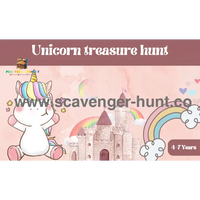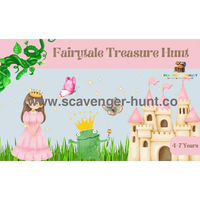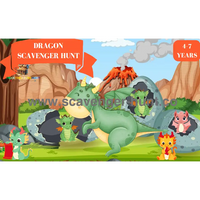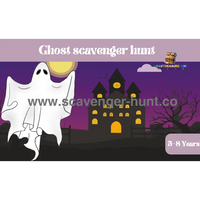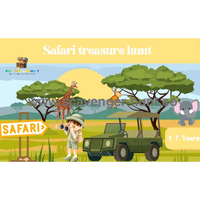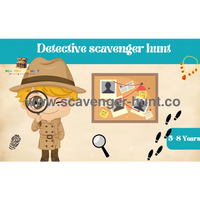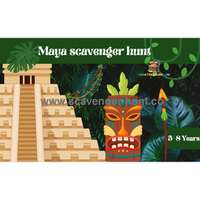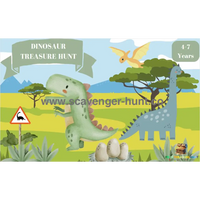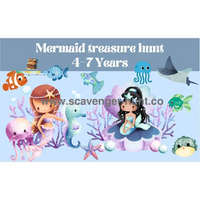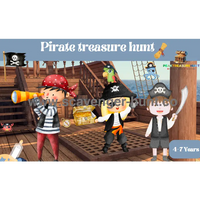💡The Basics of Scavenger Hunts for Young Explorers
Understanding Scavenger Hunts
Scavenger hunts engage children in an exciting game of discovery and problem-solving. Participants embark on a quest to gather items or complete tasks, guided by a series of clues or a pre-arranged list. For the youngest adventurers, particularly kindergarteners, these hunts are thoughtfully simplified. They are designed to be developmentally appropriate, focusing on the joy of finding objects or accomplishing simple activities. This alignment with their growth stages makes scavenger hunts a favored and educational pastime.

Key Components of a Scavenger Hunt
-
Clues and Lists: Central to every scavenger hunt are the clues or lists provided to seekers. For younger children, clues are often visual or rhyming to add to the fun while making it easier for them to understand and follow.
-
Objects and Tasks: Whether it’s finding a specific leaf in the garden or drawing a smiley face on a piece of paper, the objects to find and tasks to complete are selected with the children’s abilities in mind.
-
Setting: Scavenger hunts can be adapted to any environment, from the indoors of a home to the expansive outdoors of a park, making it versatile for any occasion or location.
A scavenger hunt is an adventure that captivates the imagination and curiosity of children, leading them on a quest filled with discovery and excitement. At the heart of this quest are several key components that ensure its success and enjoyment. Understanding these elements can help you craft a memorable and engaging scavenger hunt for kids of all ages.
Clues and Lists
The backbone of any scavenger hunt is the set of clues or lists that guide participants toward their objectives. For children, especially the younger ones, these clues are designed to be both entertaining and educational. Visual clues, such as pictures or symbols, can help pre-readers in their quest, while rhyming clues add a layer of fun and challenge for older children, making the process of deciphering them a joyous learning experience. Creating clues that are age-appropriate ensures that all participants can engage fully with the hunt, making the discovery process accessible and enjoyable for everyone involved.
-
Visual Clues: Use brightly colored images or drawings that hint at the location of the next item or task.
-
Rhyming Clues: Craft simple rhymes that lead children to the next step, enhancing their listening and comprehension skills.
Objects and Tasks
The selection of objects to find and tasks to complete is crucial in keeping the scavenger hunt interesting and doable for children. These items and activities should be chosen with the children’s age, interests, and abilities in mind, ensuring that the hunt remains challenging yet achievable. For instance, finding a specific leaf in the garden encourages observational skills and knowledge of nature, while drawing a smiley face on a piece of paper promotes creativity and fine motor skills.
-
Nature-Based Objects: Encourage exploration of the natural world by including items that can be found in a park or backyard.
-
Creative Tasks: Incorporate simple creative tasks that allow children to express themselves artistically.
Setting
The versatility of a scavenger hunt lies in its adaptability to various settings, making it a perfect activity for any occasion and location. Whether indoors, within the safety of a home, or outdoors in a park or playground, the setting can significantly influence the theme and challenges of the hunt. An indoor hunt might focus on household objects and riddles, while an outdoor hunt could incorporate elements of nature and larger physical tasks. The key is to tailor the scavenger hunt to the environment, maximizing the unique features of the setting to enhance the adventure.
-
Indoor Hunts: Utilize rooms, furniture, and everyday objects as part of the hunt.
-
Outdoor Hunts: Take advantage of the space, natural elements, and landmarks available in the chosen outdoor setting.
Conclusion
The key components of a scavenger hunt—clues and lists, objects and tasks, and the setting—come together to create an enriching and entertaining experience for children. By carefully considering these elements and tailoring them to the participants' age and interests, you can design a scavenger hunt that not only delights and engages but also fosters learning and development. Whether set in the cozy corners of a home or the expansive breadth of the outdoors, a well-planned scavenger hunt can provide endless fun and cherished memories for children and their families.


Benefits of Scavenger Hunts for Children
-
Cognitive Development: Scavenger hunts stimulate the mind, encouraging logical thinking, problem-solving, and the ability to follow directions.
-
Physical Exercise: As a physically engaging activity, it promotes exercise, coordination, and exploration of the physical world.
-
Social Interaction: When participated in groups, it fosters teamwork, communication, and social skills among children.
-
Creativity and Imagination: Deciphering clues and finding objects fuel creativity and imagination, allowing children to see their surroundings in new and interesting ways.
Scavenger hunts are much more than just an entertaining diversion for children; they are a multifaceted activity that offers a wealth of developmental benefits. From enhancing cognitive abilities to promoting physical well-being, scavenger hunts are a rich source of growth opportunities. Let’s delve into the key benefits these adventures offer to young participants.
Cognitive Development
The intellectual benefits of engaging in scavenger hunts are profound. As children navigate through the clues and challenges, they are encouraged to think logically and critically. Problem-solving becomes an integral part of the process, as participants decipher clues, determine their meanings, and decide on the best course of action to find the next item or complete a task. Moreover, following directions carefully enhances their listening and comprehension skills, fostering an environment where cognitive abilities can flourish.
-
Enhances problem-solving skills: Tackling challenges and finding solutions.
-
Promotes logical thinking: Making connections between clues and objectives.
-
Improves ability to follow directions: Interpreting and acting on given instructions.
Physical Exercise
In a world increasingly dominated by screen time, scavenger hunts offer a refreshing opportunity for physical activity. Whether it’s running across a park to locate a hidden treasure or searching around the house for a specific object, children are encouraged to move and explore. This not only aids in their physical development by improving coordination and motor skills but also promotes a healthier lifestyle through active play.
-
Encourages exercise and movement: Engaging in physical activity while searching for items.
-
Improves coordination: Navigating various terrains and spaces.
-
Promotes exploration of the physical world: Interacting with the environment in meaningful ways.
Social Interaction
Scavenger hunts often involve teamwork, making them an excellent platform for social development. Working towards a common goal, children learn the importance of communication, sharing ideas, and supporting one another. These interactions not only enhance their social skills but also teach valuable lessons in cooperation, leadership, and empathy, as they navigate the challenges and triumphs of the hunt together.
-
Fosters teamwork and cooperation: Collaborating to solve clues and find objects.
-
Enhances communication skills: Sharing ideas and strategies effectively.
-
Builds social bonds: Strengthening relationships through shared experiences.
Creativity and Imagination
One of the most delightful aspects of scavenger hunts is the way they spark creativity and imagination. Deciphering clues often requires a creative thought process, encouraging children to think outside the box. The thrill of discovery and the mystery of what lies ahead stimulate their imagination, allowing them to see their surroundings in new and intriguing ways. This creative exploration is crucial for cognitive development, opening doors to innovative thinking and problem-solving approaches.
-
Stimulates creative thinking: Finding inventive solutions to clues and tasks.
-
Fuels the imagination: Envisioning possibilities and interpreting clues creatively.
-
Encourages a fresh perspective: Seeing the familiar environment through the lens of adventure and discovery.
Conclusion
Scavenger hunts offer a comprehensive developmental experience for children, touching on aspects of cognitive growth, physical health, social interaction, and creative exploration. These benefits underscore the value of scavenger hunts not just as a fun pastime but as a potent educational tool. By participating in these adventures, children gain invaluable skills and experiences that contribute to their overall development, making scavenger hunts a highly recommended activity for young explorers.


Organizing a Scavenger Hunt
To set up a scavenger hunt that is both fun and age-appropriate for young explorers, consider the following steps:
-
Select a Theme: Choose a theme that resonates with the interests of the participating children, such as pirates, animals, or superheroes, to make the hunt more engaging.
-
Create the Clues: Design clues that are simple yet challenging enough to keep them intrigued. Pictures, maps, and puzzles are great for younger children.
-
Determine the Play Area: Based on the number of participants and their ages, decide on a safe and manageable area for the hunt.
-
Prepare the Rewards: While the journey is rewarding in itself, having small prizes at the end can add to the excitement.
-
Safety First: Ensure the entire scavenger hunt is under adult supervision, especially when younger children are involved, to keep the adventure safe and enjoyable.
Creating a scavenger hunt that captivates and delights young explorers requires thoughtful planning and creativity. This chapter outlines the essential steps to organizing a scavenger hunt that is not only age-appropriate but also packed with fun and learning opportunities. By following these guidelines, you can ensure a memorable adventure for all participants.
Select a Theme
A compelling theme is the cornerstone of an engaging scavenger hunt. It sets the stage for the adventure and helps to immerse participants in the experience. When choosing a theme, consider the interests and ages of the children involved. Themes like pirates, animals, superheroes, or even space exploration can spark excitement and curiosity. A well-chosen theme can turn a simple hunt into an epic adventure, making the experience all the more memorable for the young participants.
-
Pirates: A quest for hidden treasure across the seven seas.
-
Animals: A safari adventure to find exotic creatures.
-
Superheroes: A mission to save the world by finding lost artifacts.
Create the Clues
Clues are the heartbeat of a scavenger hunt, guiding children from one point to the next. Crafting clues that are age-appropriate yet challenging enough to keep the excitement alive is crucial. For younger children, visual clues like pictures or maps can be particularly effective, while puzzles or riddles may engage older children more deeply. The clues should be designed to prompt critical thinking and problem-solving but also be clear enough to prevent frustration.
-
Visual Clues: Use colorful images or symbols to lead the way.
-
Maps: Create simple maps that guide children to the next location.
-
Puzzles and Riddles: Challenge older kids with brain teasers that relate to the theme.
Determine the Play Area
The choice of play area can significantly influence the scavenger hunt's success. Whether indoors or outdoors, the environment should be safe, manageable, and suitable for the age group of the participants. Consider the size of the area and the number of children involved to ensure everyone can participate fully without overcrowding or safety concerns. Indoor hunts might utilize different rooms and hiding spots, while outdoor hunts can take advantage of parks, gardens, or backyards.
-
Indoors: Use rooms, closets, and furniture as hiding spots.
-
Outdoors: Explore gardens, parks, and playgrounds for a broader adventure space.
Prepare the Rewards
While the journey of the scavenger hunt offers its own rewards in terms of fun and learning, having tangible prizes at the end can heighten the excitement. These rewards don’t have to be extravagant; small tokens that fit the theme of the hunt or certificates of achievement can provide a sense of accomplishment. The anticipation of a reward can motivate participants and add an extra layer of enjoyment to the experience.
-
Themed Prizes: Offer small toys or items that match the scavenger hunt's theme.
-
Certificates: Create personalized certificates for each participant.
Safety First
Above all, the safety of the children should be the top priority. Ensure that the scavenger hunt is under constant adult supervision, particularly for younger children. Assess the play area for potential hazards and plan the route to avoid any dangerous spots. Providing clear rules and guidelines at the beginning can help prevent accidents and ensure a safe, enjoyable adventure for everyone.
-
Supervision: Always have adults overseeing the hunt.
-
Safety Checks: Inspect the area beforehand to remove any dangers.
-
Clear Rules: Establish guidelines to keep everyone safe during the hunt.
Organizing a scavenger hunt is an opportunity to create an unforgettable experience for children, filled with challenges, discovery, and joy. By carefully selecting a theme, crafting engaging clues, choosing a suitable play area, preparing rewards, and prioritizing safety, you can design a scavenger hunt that not only entertains but also promotes learning and growth. With these steps as your guide, you're ready to embark on the exciting journey of organizing a scavenger hunt that will be remembered and cherished by all participants.


Conclusion
Scavenger hunts are a fantastic way for young explorers to learn, grow, and have fun. By engaging in these adventures, children not only enjoy the thrill of the hunt but also develop invaluable skills that will aid them in their educational journey. With a little creativity and planning, a scavenger hunt can turn any ordinary day into an extraordinary adventure.
Scavenger hunts stand out as a remarkable blend of entertainment, education, and exploration, offering young adventurers a unique way to engage with the world around them. These quests are not just about the excitement of the search or the joy of discovery; they are deeply enriching experiences that foster a wide array of skills in children. From cognitive development and physical fitness to social interaction and creative expression, scavenger hunts provide a comprehensive platform for growth and learning.
The beauty of a scavenger hunt lies in its versatility. Whether it unfolds within the cozy confines of a home or sprawls across the vast expanses of a park, each hunt is a universe of possibilities waiting to be explored. With themes as varied as the interests of the children themselves, every scavenger hunt is a tailored adventure that speaks directly to the hearts and minds of its participants.
Moreover, the process of organizing a scavenger hunt is itself a journey of creativity and imagination for parents, teachers, and guardians. It presents an opportunity to craft an experience that not only entertains but also educates, weaving together the elements of play and learning into a seamless tapestry of fun. The rewards of such an endeavor extend beyond the tangible prizes at the end of the hunt; they reside in the laughter, the teamwork, the problem-solving, and the sheer delight of discovery that children experience along the way.
In conclusion, scavenger hunts are more than just a game; they are a gateway to adventure, a catalyst for learning, and a treasure trove of memories that children and adults alike will cherish. By embracing the spirit of exploration and the joy of the hunt, we can transform ordinary days into extraordinary adventures and provide our young explorers with the tools they need to learn, grow, and thrive. So, let the hunt begin, and may every clue discovered and every challenge overcome lead our children one step closer to realizing their full potential.
Discover our complete Would You Rather Questions collection.
Discover our Complete Scavenger Hunts Collection.




























